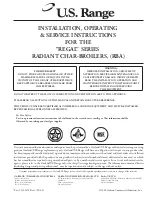
21
OPERATING THE BOILER
Draft Regulators:
Barometric draft regulator is required
for controlling draft through boiler. Mount barometric draft
regulator in chimney connector. Refer back to section on
“Chimney And Chimney Connections”. Once draft regulator
is installed, use draft gauge to adjust to proper opening:
A.
Combustion chamber over fire draft shall be -0.01”
WC to -0.02” WC.
B.
Stack draft will be approximately -0.02” WC. to
-0.04” WC.
C.
Larger installation, greater draft will be required in
stack to obtain desired over fire draft.
Start:
Fill entire system with water. Vent all air from
system following section for Filling The Boiler.
Fuel Units And Oil Lines:
•
Install oil line(s) to oil burner.
•
Recommend using heavy wall copper tubing and
flared fittings, not compression fittings.
• All connections and joints must be absolutely airtight.
Use an appropriate non-hardening thread sealing
compound on the threaded connections, not Teflon
tape.
•
See fuel unit data sheet furnished with the burner for
sizing, lift, and length of tubing recommendations.
Oil burner is equipped with single stage fuel unit for single
pipe installation. This is satisfactory where fuel supply is on
same level as or above burner permitting gravity flow of oil.
Per NFPA 31 requirements, never exceed 3 psig pressure to
inlet side of fuel unit.
When necessary to lift oil to burner, two pipe installation
is required. Run return line between fuel unit and oil
supply. Refer to fuel unit instructions furnished with burner
for specific instructions on two pipe installations. Do not
exceed fuel unit manufacturer’s recommendations for
running vacuum.
NOTICE
If lift exceeds 14 feet for Beckett burners, two stage
fuel unit is required with return line.
Install oil filter of adequate size inside building between
tank shutoff valve and oil burner. For ease of servicing,
locate shutoff valve and filter near oil burner.
Air Supply For Combustion:
•
Do not install boiler in rooms with insufficient air, unless
corrective steps are taken.
•
It may be necessary to install windows or cut holes in
a door to rooms used for supply air to obtain sufficient
combustion air and prevent less than atmospheric air
pressure in that room.
•
If there is a lack of combustion air, burner flame will be
dark orange and formation of soot will occur in heating
unit.
•
In buildings of conventional frame, brick, or stone
construction that do not have utility rooms, basement
windows, or stair doors, air infiltration is normally
adequate to provide enough air for combustion and for
operation of barometric draft control.
• Room used for supplying combustion air should be
isolated from any area served by exhaust fans.
• Refer to the section "Fresh Air For Combustion" for
additional sizing guidelines.
Nozzles And Electrodes
:
Use proper size, spray angle,
and spray pattern nozzle.
To install nozzle, remove nozzle line electrode assembly,
if necessary remove retention ring assembly, and install
and tighten nozzle. Take care not to damage electrode
insulators or bend electrode tips.
After installing nozzle, reassemble nozzle line electrode
assembly and set electrode tip spacing.
Depending on burner type, electrode tip spacing may
need to be set prior to reassembling nozzle line electrode
assembly.
Refer to following pages for setting electrode tip spacing.
Final Burner Adjustments:
Final burner adjustments
must be made using combustion test instruments. Refer
to preliminary burner settings charts for initial startup. Set
burner accordingly.
•
Check draft over fire to verify it is between -0.01” WC
and -0.02” WC, adjust draft as necessary.
•
After operating 10 minutes to warm up boiler, use
combustion test equipment to take smoke reading in
flue pipe between boiler and draft regulator.
•
Smoke reading should be zero to trace (Shell Bacharach
Scale).
•
A new boiler requires more than 10 minutes to burn
clean due to oil film on new heat exchanger.
•
If smoke reading is zero, gradually close burner’s air
adjustment to obtain smoke reading showing trace
smoke reading. Once smoke reading is trace, measure
CO
2
and as insurance margin increase air to sufficiently
reduce CO
2
by ½% to 1%.
If clean fire cannot be obtained, it is necessary to verify
burner head and electrode alignment. Proper electrode
alignment figures are presented on following pages. If
fire continues to be smoky, replace nozzle with correct
replacement.
Once burner is completely adjusted, start and stop burner
several times to assure good operation with no fluttering
or rumbling. Verify there are no oil leaks. Record nozzle
size, oil pressure, combustion readings, and air settings on
tag or label attached to burner or, boiler.
PN 240013023, Rev. B [12/31/2020]








































